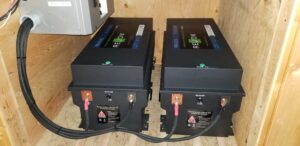Solar Battery FAQs – LiFePO4/LFP
Solar Battery FAQs - LiFePO4/LFP
Different types of battery chemistry work best in different applications depending on your goals and how they will be used. Traditional renewable energy battery chemistries – flooded lead acid (FLA) for one – require some form of regular maintenance to keep the batteries operating at peak efficiency and to preserve their full cycle life. FLA, AGM, gel and other renewable energy batteries all have limitations on how far and how frequently they can be discharged, and all but those with carbon as part of their chemistry need to be fully recharged after each cycle to protect them from excessive degradation which results in premature costly battery replacement.
But lithium based technology is different. It allows for much more flexibility in how you use your battery system because most lithium batteries allow you to use 100% of their storage capacity, and they don’t have to be recharged fully each time. Plus, there is no maintenance. Lithium batteries also have a longer usable life than traditional types of solar batteries, meaning despite a larger upfront investment, over the life of your system the cost of ownership is much lower. If you’re conscious of long-term cost, system maintenance and need flexibility in your battery usage, a lithium-based battery system might be the right option for you!
Their are two main lithium chemistries suitable for solar and other renewable energy applications: Lithium Ion (LION) and Lithium Iron Phosphate (LiFePO4 or LFP). Browse Lithium Batteries.
Our primary reasons for choosing battery systems using LiFePO4 technology are safety and overall value. Not only are LiFePO4 batteries chemically safer than other lithium chemistries when put into extreme conditions, they also have a better warranty, last longer, and cost less over the life of the system! You can check out our article about the advantages of LiFePO4 technology here!
It depends on your power production and the inward flow (charge rate) of energy. On average it can take roughly 1-5 hours for a LiFePO4 battery to charge, depending on size, model, the exact application and the charging source. When we design your system, we always ensure you are getting the appropriate size battery system for your needs.
LiFePO4 chemistry has 2x the usable capacity than an equivalently rated lead-acid battery under the same conditions! Definitely let us know if you are replacing lead-acid batteries so we can assist you with selection – you may need a smaller LiFePO4 battery bank than your lead-acid battery bank. As a bonus, unlike lead-acid batteries, LiFePO4’s rate of discharge has little to no effect on delivered capacity!
LiFePO4 battery chemistry can be discharged up to 100% without any damage to the battery. This is unique to lithium-based battery systems. Traditional lead-acid batteries can only be discharged to 50% of their capacity before they need to be recharged.
Yes – within reason. When exposed to extreme cold the charge current must be adjusted appropriately. In warmer temperatures, the charge control device that is either built into a LiFePO4 battery or connected as a part of the larger system will protect the battery from damage. Both ReLiON and Blue Ion LiFePO4 batteries include additional battery management systems integrated into the battery for additional safety, monitoring, and regulation. A well-designed battery management system protects and monitors a lithium-ion battery to optimize performance, maximize lifetime, and ensure safe operation over a wide range of conditions. No matter the temperature fluctuations, the system should be protected from the elements. Refer to the manufacturer’s specifications on your specific battery to determine how to best care for your battery if it will be exposed to extremely warm or cold weather.
I am text block. Click edit button to change this text. Lorem ipsum dolor sit amet, consectetur adipiscing elit. Ut elit tellus, luctus nec ullamcorper mattis, pulvinar dapibus leo.A great question, and one that we are asked frequently. Your backup battery system should be enough to cover the important electrical items in your home in a blackout. This varies from home to home and person to person. Find out about Common Essential Loads and Impractical Essential loads to start making your own list. Then use our online Load Calculator to find out how much power all those items use. You can email your list directly to us from our website, and we can then help you find just the right batteries and equipment to keep you up and running.
It depends. Some lithium iron phosphate batteries can be wired in series and parallel, but most that are used for solar come from the manufacturer internally wired in a “package” to provide a specific voltage and amp hour rating. Always refer to the manufacturer specifications before connecting multiple LiFePO4 batteries together to protect yourself and your batteries.
 LiFePO4 batteries are rated to last from 10 to 21 years depending on the brand, size of system, application, and a variety of other factors. Performance warranties will vary—however, the performance warranty is the bare minimum the manufacturer will guarantee for the product. This is great news for you! A product with a 10-year warranty is guaranteed by the maker to last at least that long. Frequently these items will last much longer! We will be able to give you a more detailed idea of how long your battery system may last given your specific battery system and unique application/use.
LiFePO4 batteries are rated to last from 10 to 21 years depending on the brand, size of system, application, and a variety of other factors. Performance warranties will vary—however, the performance warranty is the bare minimum the manufacturer will guarantee for the product. This is great news for you! A product with a 10-year warranty is guaranteed by the maker to last at least that long. Frequently these items will last much longer! We will be able to give you a more detailed idea of how long your battery system may last given your specific battery system and unique application/use.
 Do Lithium Iron Phosphate (LiFePO4) batteries have to be located in a specific location or position?
Do Lithium Iron Phosphate (LiFePO4) batteries have to be located in a specific location or position?
No! One of the many great things about LiFePO4 technology is that the lack of liquid in them and the safety of the chemistry allows for greater flexibility in location and placement; put them where it best suits the application and your system, even inside your living space.
